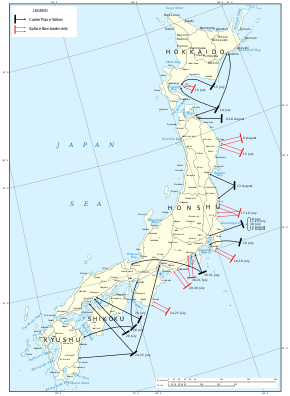Allied naval bombardments of Japan during World War II
The Allied naval bombardments disrupted industrial production in the cities targeted, and convinced many Japanese civilians that the war was lost.
Attacks by Allied submarines and surface ships had also cut most of the country's trade routes, and US Navy aircraft carrier task groups had raided locations in the home islands on several occasions.
[5] On 1 July 1945, the United States Third Fleet sortied from Leyte Gulf in the Philippines under the command of Admiral William Halsey to attack the Japanese home islands.
USAAF B-29 Superfortress and B-24 Liberator aircraft also conducted photo reconnaissance flights over much of Japan in search of airfields and facilities which could be attacked by the Third Fleet.
[6] The Third Fleet's main component, Task Force 38 (TF 38), began striking targets in Japan on 10 July under the command of Vice Admiral John S. McCain.
[7] The first Allied bombardment of a Japanese coastal town was conducted on 14 July in conjunction with the air attacks on Hokkaido and northern Honshu.
A bombardment group commanded by Rear Admiral John F. Shafroth Jr. designated Task Unit 34.8.1 (TU 34.8.1) was detached from TF 38 to attack the ironworks at Kamaishi in northern Honshu.
The resulting smoke prevented US Navy aircraft from being able to support or spot for the warships, which continued to fire accurately on predetermined targets.
This was one of the first times that the Americans had used aerial photography to assess damage from a naval bombardment, and the interpreters placed too much weight on the fact that none of the ironworks' buildings had been destroyed.
TU 34.8.2 was commanded by Rear Admiral Oscar C. Badger and comprised the battleships Iowa, Missouri and Wisconsin, the light cruisers Atlanta and Dayton, and eight destroyers.
[16] Also that night, a force of four cruisers and six destroyers cruised along the east coast of Honshu seeking to attack Japanese shipping, but did not locate any targets.
Later that day, TU 34.8.2 detached from the carrier force to bombard targets around the city of Hitachi, about 80 mi (130 km) northeast of Tokyo.
This force was commanded by Rear Admiral Badger and comprised the battleships Iowa, Missouri, Wisconsin, North Carolina, Alabama, and HMS King George V, light cruisers Atlanta and Dayton, and eight American and two British destroyers.
[24] The official history of the US Navy in World War II states that "individual Japanese" considered the naval bombardment to have been more terrifying than the air attack.
[23] On 18 July TFs 37 and 38 conducted further air strikes in the Tokyo area, with the American force's main effort being an attempt to sink the Japanese battleship Nagato at Yokosuka Naval Base.
[25][26] After completing its strikes on the Tokyo region, the Allied fleet conducted an at-sea replenishment from 21 to 23 July before attacking Kure and the Inland Sea from the 24th to the 28th of the month.
[27] On the night of 24–25 July, CruDiv 17 patrolled the Kii Channel and bombarded the naval seaplane base at Kushimoto, a landing field near Cape Shionomisaki, and a radio station.
[28][29] On 29 July, a group of warships was detached from the main body of the Allied fleet to bombard the city of Hamamatsu, which lies on the south coast of Honshu between Nagoya and Tokyo.
No ships were located, and in the early hours of 31 July the squadron sailed deep into the gulf and fired 1,100 rounds of 5-inch shells during seven minutes at a railway yard and aluminum plant in Shimizu.
[26][33] During the last days of July and into early August, the Allied fleet sailed away from the Japanese coast to avoid a typhoon and allow the ships to replenish their stocks of fuel and ammunition.
[34][35] As part of these operations off northern Japan, Kamaishi was bombarded again on 9 August in the mistaken belief that the ironworks had not been badly damaged.
[10][35] King George V did not participate in this action as mechanical problems affecting two of her propeller shafts meant that she was unable to sail at the speed specified for the bombardment force.
[39] A further bombardment by King George V, three light cruisers, and escorting destroyers was planned to be conducted against an unspecified Japanese target on 13 August.
[42] A party of eight men from Barb was landed on the east coast of Sakhalin on 23 July and planted demolition charges on a railroad track.
Shortly after the men began rowing back to the submarine the charges were triggered by a passing train; 150 people, including civilians, were killed.
[47] The other submarine bombardment took place during the morning of 24 June, when USS Trutta fired some shells at the island of Hirado Shima in the Tsushima Strait between Japan and Korea.
[48][49] Although the naval bombardments did not result in the reaction the Allies were hoping for from the Japanese military, they disrupted the country's steel industry.
While several of the factories attacked were operating at reduced capacity, the important Kamaishi and Wanishi Iron Works suffered heavy damage when they were bombarded in July and August.
[53] However, such attitudes did not contribute to bringing the war to an end as the views of civilians had little influence on the Japanese Government's decision to surrender.
The casualties attributed to naval bombardments and other causes included 1,739 fatalities, 46 persons who were still classified as missing and 1,497 people who were wounded.




